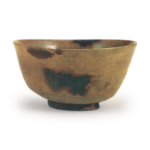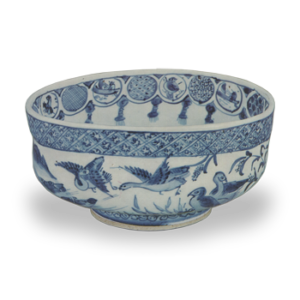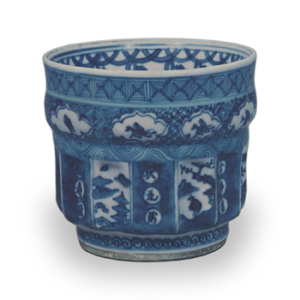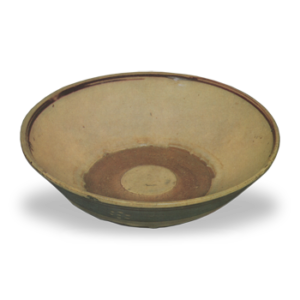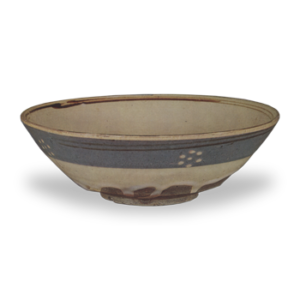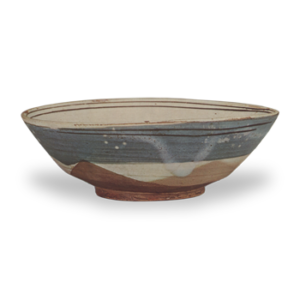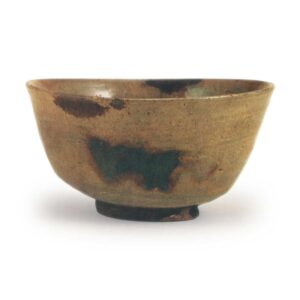
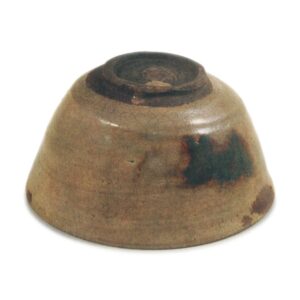
Chuko Meibutsu
Height: 7.5-8.3cm.
Diameter: 14.4-】4.7cm
Outer diameter of foot ring: 5.6-6.0cm
Height of foot ring: 0.9cm
In the eighth volume of the Taisho Meiki Kan (A Guide to Great Tea Bowls of the Taisho Period), in addition to the Sekido family tea bowl, eight other Haku-an tea bowls are listed: Fuyuki, Okuda, Toki, Sosen, Sakai, Kuchiki, and Tennoji. There are also several other pieces that have been passed down in the Konoike family, but Hakuan is a tea bowl that has been particularly treasured in Japan since ancient times, as there are so few surviving examples.
Of these, the Sekido family’s Hakuan is considered to be the original version of the Hakuan and is considered to be the most famous. It has a bulging shape and a moist glaze. Even though it is the same Hakuan, it is softer and more approachable than other tea bowls, and is particularly highly regarded. The “Mekurikusa” lists the seven characteristics of Hakuun as namako-yaku, tobiyaku, shirotsuchi, biwa-iro, takadai no taketsu, katahusu, and chadamaru, while the “Meibutsu Mekuribunsho” lists the ten characteristics (twelve items) of Hakuun as biwa-iro color, fresh sea cucumber medicine, stains, high-fired thin-walled, high-fired crepe-dyeing, potter’s wheel marks, unrefined clay, tea-drip marks, small inlay, slightly curved shape, (bamboo nodes), (flying medicine).
Just as In the same way that the well is particularly valued in Korean tea bowls, the Hakuun is particularly valued in Japanese tea bowls, and this is probably why these features are mentioned.
The Hakuun is a mysterious tea bowl for which it is still unclear when and where it was made.
From ancient times it is said to be from Seto, but it is not clear whether it is from Seto, Mino or Korea.
Sekido The base of the Hakuan bowl is made of a rough, sticky, eggshell-colored clay, and the exposed parts are dirty and darkened. A slightly thick, moist glaze with a slight iron content is applied to the inside and outside, and there are rough cracks on the inside and outside. The part below the waist is exposed, and there is a spot where powder has been sprinkled, commonly referred to as “flying glaze”, inside the foot ring.
The firing is slightly oxidized, and the glaze is similar to that of yellow Seto ware, but it has a somewhat dull, cloudy appearance. The glaze is a light yellowish-brown color, and there are areas that are speckled with bright reddish patches. The Manzo is thick, but the rim is relatively thin and slightly warped, and the large foot supports the bowl-shaped body. The foot is low and resembles a bamboo joint, and the bottom is thinly scraped, with a whorl on the inside that was made by turning the pot on the wheel to the left. also has a tea-drip well, and is a tea bowl that fully embodies the seven principles of Haku-an.
Bag: gold-colored silk
Inner box: paulownia wood, plain finish, paper pasted to the lid: “Seto Haku-an tea bowl” by Enshu Kobori
Middle box: black lacquer, beveled red lacquer, paper pasted to the lid: “Haku-an” by unknown author
Outer box Paulownia wood, lid: “Seto teacup, Haku-an” by unknown author
One accompanying note
It is said that this teacup was owned by Soya Haku-an, a physician in the shogunate, and then passed to the Inaba family of Yodo, and after that it changed hands several times before being acquired by Kajima Seizaemon, a wealthy merchant in Fukagawa, Edo. Meiji era

